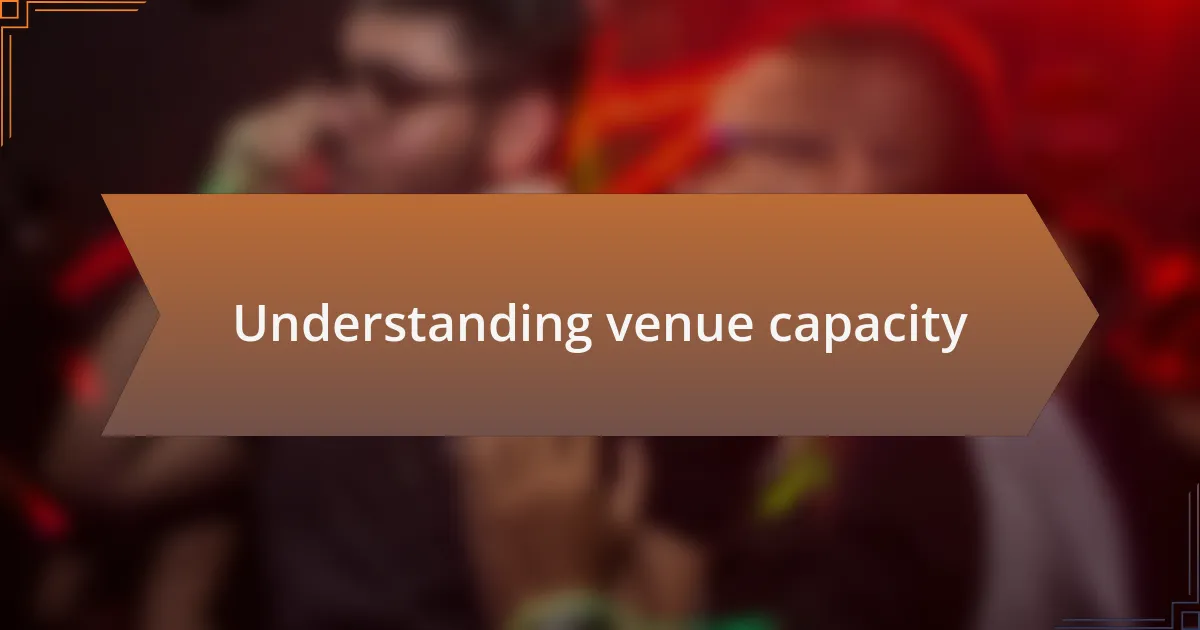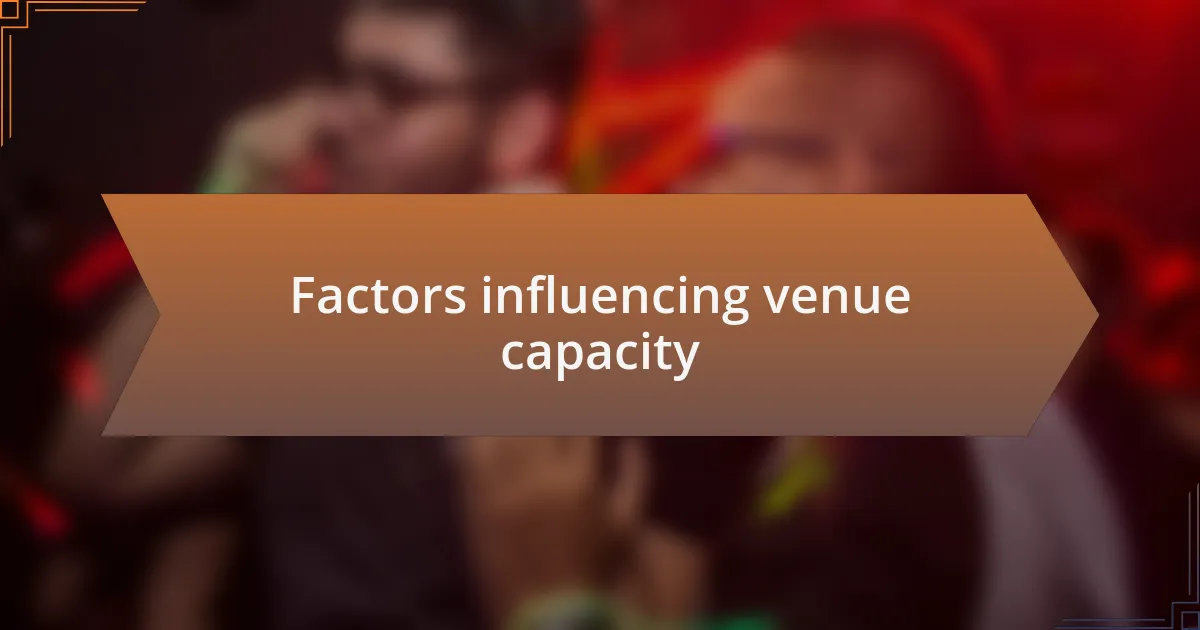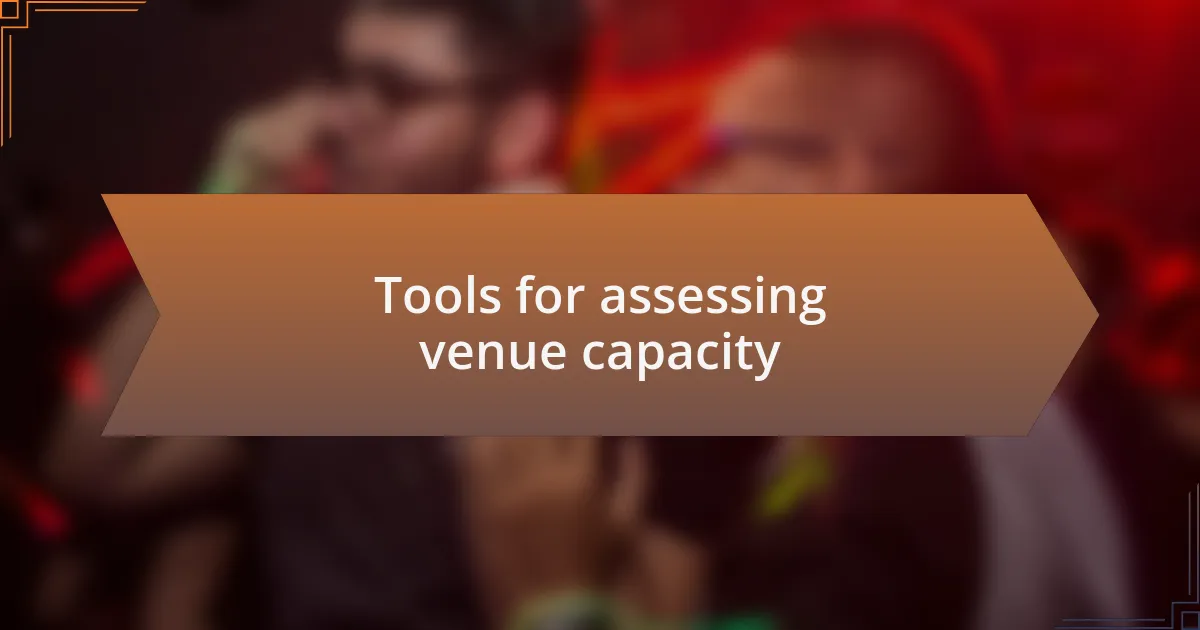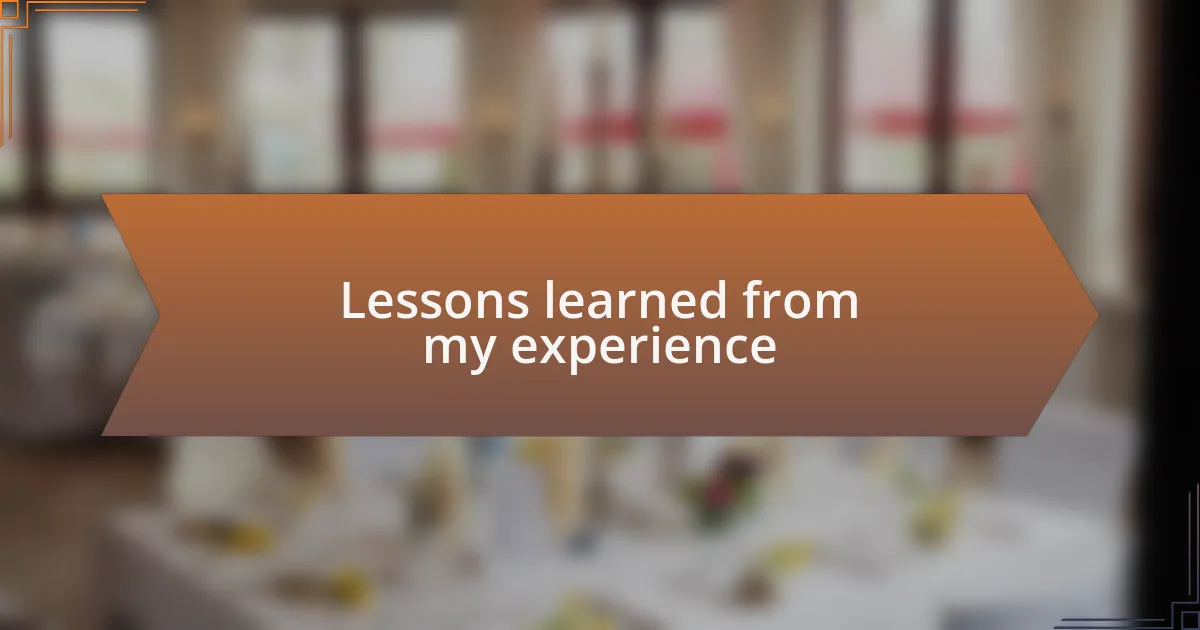Key takeaways:
- Understanding venue capacity requires considering layout, amenities, and safety regulations to ensure a comfortable experience for attendees.
- Using technology and feedback from previous events can greatly enhance the assessment of venue capacity and guest satisfaction.
- Flexibility in seating arrangements and collaboration with venue staff are crucial for optimizing event flow and attendee enjoyment.
- Accessibility and visualization of guest movement are essential components in effective venue assessments to create a welcoming atmosphere.

Understanding venue capacity
Understanding venue capacity is crucial for any event planner. It’s not just about fitting people into a space; it’s about creating an experience where attendees feel comfortable and engaged. I remember a time when I underestimated a venue’s capacity—what a disaster! We were unprepared for the number of guests, leaving many standing awkwardly in corners.
When assessing venue capacity, I’ve learned to consider various factors beyond mere square footage. For instance, how will seating arrangements affect movement and interaction? Will there be space for vendors, exhibits, or activities? I often find myself pondering these questions as I walk through a venue, imagining how the space can be optimized for engagement.
Also, it’s essential to take into account fire codes and safety regulations; they can vary significantly. Did you know that many venues have strict guidelines about the maximum number of people allowed? I’ve found that knowing these limits not only helps with compliance but also ensures guests have a safer and more enjoyable experience. Isn’t it amazing how understanding these details can elevate the overall event?

Factors influencing venue capacity
When evaluating venue capacity, one primary factor to consider is the layout of the space. I remember touring a venue with a beautiful open floor plan, but when it came down to it, the columns in the middle disrupted line of sight and movement. It made me wonder—how often do planners overlook the impact of architectural features on capacity?
Another significant aspect is the amenities available within the venue. Access to restrooms, catering facilities, and technology can drastically alter how many people can comfortably fit. During one event, I found that inadequate restroom facilities led to long lines and frustrated guests. Thinking back, I realized that the venue’s capacity should also reflect the comfort and convenience for attendees. How can we call an event successful if our guests are left waiting or uncomfortable?
Lastly, consider your event’s nature when assessing capacity. For example, a networking event requires more space for mingling than a seated dinner. I’ve planned events where the vibe was stifled because guests were crammed in without room to move. I can’t stress enough the importance of envisioning not just what the space can hold, but how that space will serve the experience you want to create.

Tools for assessing venue capacity
When it comes to assessing venue capacity, technology can be an invaluable ally. For instance, I’ve used software like RoomSketcher and Eventbrite to create floor plans and simulate different seating arrangements. These tools not only help visualize a layout but also provide estimates on how many guests can fit without feeling squished—something I’ve learned is crucial for attendee satisfaction.
Another tool that has served me well is physical space planners, like measuring tape and graph paper. I cannot tell you how many times I’ve resorted to old-school methods after my digital plans didn’t quite translate to the actual venue. Standing in the space, measuring it out by hand, often brought a deeper understanding of both capacity and flow. Have you ever felt the difference between a digital prediction and the real-world application? It’s like the gap between theory and practice suddenly becomes very real.
Lastly, I swear by feedback from previous events when choosing a venue. After hosting a few gatherings, I learned to always ask participants about their comfort level. Their insights led me to rethink capacity—an event could fit 200 guests on paper, but it was the actual flow and experience that mattered most. Isn’t it fascinating how the voices of our attendees can shape our future planning in such a meaningful way?

My first venue capacity assessment
After diving into my first venue capacity assessment, I still remember the excitement mixed with a hint of nervousness. I approached the venue with my measuring tape in hand, feeling like a child embarking on a treasure hunt. As I measured the walls and counted the chairs, I realized that understanding the space was more than just numbers; it was about envisioning the atmosphere I wanted to create.
One surprising detail that shaped my perspective was the width of the aisles. Initially, I had focused solely on how many guests could fit in the seats, but when I considered movement and accessibility, it became a game-changer. Have you ever walked into a crowded event and felt immediately overwhelmed? I wanted to avoid that; it became clear to me that an inviting flow was just as crucial as hitting the correct number.
Reflecting back, I can’t help but smile when I think about the feedback I received after that first event. Attendees expressed how comfortable they felt navigating the space, which validated my efforts during the assessment. It was a rewarding reminder that capacity isn’t just about fitting in more chairs—it’s about curating an experience that resonates with everyone present. How often do we really think about how a venue influences the overall vibe of an event? It’s a lesson I carry with me in every new venue evaluation.

Lessons learned from my experience
As I delved deeper into the world of venue capacity assessments, one striking lesson I learned was the importance of flexibility. During a particularly challenging assessment, I underestimated the need for various seating arrangements based on event types. When the organizer expressed a preference for a different layout, I quickly realized that adaptability could enhance the guest experience significantly. Have you ever been to an event that felt too rigid? It’s those moments that taught me to envision multiple configurations for every space.
Another significant takeaway was the necessity of collaboration with venue staff. I remember casually chatting with the venue manager during one assessment, which opened my eyes to insights I would have missed otherwise. Their expertise on traffic flow and guest behavior was invaluable. It made me think—how often do we overlook the knowledge of those who operate these spaces daily? Building those relationships not only enriched my assessments but also improved the overall event execution.
Finally, I learned that the math behind capacity isn’t just about the numbers but also about the moods they create. During a bustling event, I noticed how cramped spaces squeezed the energy out of the room, while more generous layouts encouraged mingling and laughter. Have you ever felt the difference a little breathing room can make? Each assessment now feels like a sculpting process where the goal is to craft an environment conducive to joy and connection.

Tips for effective venue assessment
When assessing a venue, always prioritize accessibility. I recall one event where the chosen location lacked adequate ramps and entrances for guests with mobility challenges. It was a hard lesson that made me ask, how considerate are we being if we overlook these details? Ensuring everyone can comfortably enjoy the event shouldn’t just be an afterthought; it should be foundational to our assessment.
Another tip is to visualize the flow of people. During one assessment, I walked through the space while actively imagining how guests would navigate it. This mental exercise illuminated potential bottlenecks and highlighted areas for improvement. Have you ever felt trapped in a crowd at an event? That experience reinforced my belief that a well-planned layout fosters a smoother experience and keeps the energy high.
Don’t forget to consider the community around the venue. Once, I hosted an event near a bustling market, which added vibrancy but also noise. Observing how external factors can influence the atmosphere is crucial. What ambiance do you want to create? Knowing the local environment can help shape not just the venue choice but also the overall event feel.